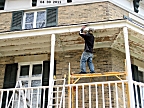website watertownhistory.org
ebook History of Watertown, Wisconsin
William & George Fred Keck
1912
FEMALE PORTRAIT
painted in 1912 by Watertown
architect George Fred Keck
1935
BUILT FIRST SOLAR HOUSE IN WATERTOWN,
Wilde residence, 305 Elizabeth
1940

 Octagon
House porches being worked on, April of 2011.
Octagon
House porches being worked on, April of 2011.
"The
Board of Directors was often plagued with the question of what constituted good
repairs. Were the porches a part of that
pressing need? As early as June 1940, Architect George Fred Keck offered to
draw plans for the porch restoration project.
A year later a five hundred dollar donation accompanied blueprints for
the restoration of the verandas. These
funds were made available from the Honorable Joe. E. Davies, Ambassador to
Belgium and Russia." - John Richards: The Hill and The Mill,
page 99.
1967
05 30 RECORD HOUSES OF 1967
A
house designed by two members of the Keck family of Watertown — George Fred
Keck and William Keck, architects with offices at 612 North Michigan Avenue,
Chicago, is one of 20 award winning houses selected for inclusion in “Record
Houses of 1967,” a publication which is featuring houses of three-dimensional
planning “which enhances the sense of space and provides indoor-outdoor living
in both vertical and horizontal areas.”
The house designed by the Kecks is known as the Karlin House and is
located at 5812 Blackstone Avenue, on a 50-foot lot in Hyde Park near the
University of Chicago. The house is a
single-family unit. The two architect
brothers are sons of the late Mr. and Mrs. Fred G. Keck of Watertown. The family business has been the Keck
Furniture Co. here, which is now into its second century of operation. WDT
1969
05 21 COLLEGE OF FELLOWS, AMERICAN INSTITUTE
OF ARCHITECTS
William
Keck, an architect in Chicago for 38 years, has been elected to the College of
Fellows of The American Institute of Architects, a lifetime honor bestowed for
outstanding contribution. A former
resident of Watertown, he will be formally invested during special ceremonies
at the annual convention of the AIA in Chicago, June 22-26. Mr. Keck was born in Watertown, Wisconsin in
1908, and received a B.A. degree in architecture form the University of
Illinois at Urbana, in 1931. A partner
in the firm of George Fred Keck-William Keck, Architects. Mr. Keck's work has been devoted to housing
and commercial work.
1981
05 17 HOUSING HALL OF FAME
Architect
George Fred Keck, a native of Watertown, was inducted into the Housing Hall of
Fame in recognition of his lasting contribution to the cause of providing all
Americans with decent and affordable homes.
Keck, who passed away last November in Chicago at the age of 85 and
worked in partnership with his brother, William, was the first American architect
to demonstrate the potential of passive solar energy. At a time when the nation enjoyed seemingly
inexhaustible supplies of cheap fuel, he was an advocate of thermally efficient
and functional modern design in housing.
Keck built his first solar house in Watertown in 1935, the Wilde
residence located at 305 Elizabeth Street.
Using the “greenhouse” effect, he was able to achieve fuel savings of 15
to 20 percent. Small windows were built
on the north side of the home; wide floor-to-eaves windows on the south. Trees
were planted to reduce southern exposure during the summer. WDT
2018
-- -- ONLINE ARTICLE
Architects
William and George Fred Keck were known as visionaries. They boldly pushed modern design as far back
as the 1930s, when most homeowners didn’t dream beyond cookie-cutter
Colonials. The Keck brothers, two of
five boys, were born and raised in Watertown.
Clearly
the House of Tomorrow’s creator, George Frederick “Fred” Keck, wanted to make
an impression. Keck was an ambitious
young architect who worked with his brother William in Chicago. He saw the fair as an opportunity to
introduce Modernist architecture to the masses, and realized that, rather than
working with just one manufacturer, he could get multiple sponsors on board and
experiment with a wide range of new materials.
Libbey-Owens-Ford, for example, supplied the glass. Goodyear provided
rubber floors for some of the rooms, and General Electric contributed the
latest appliances.
Keck
used an octagonal brick house in his hometown as
an inspiration for the building’s unusual form, and the iconoclastic architect
Buckminster Fuller’s Dymaxion House (1930) may have influenced him as well. The
dodecagon came about for purely practical reasons; that shape simply worked
best with Libbey-Owens-Ford’s available sizes of glass panes.
The
firm of Keck and Keck went on to design hundreds of quietly groundbreaking
passive solar houses, decades before environmental design became fashionable.
“Keck was one of the first guys out there saying, ‘We can heat houses with the
sun!’” says Chicago architect and writer Stuart Cohen. “He is not adequately
credited for how revolutionary he was at the time.” Full
text of Preservation Magazine online article
CROSS
REFERENCES:
Keck and Keck (Paperback) by Robert
Boyce
Architect
George Keck designed and built 204 E Water St Watertown, WI for his brother.
![]()
History of Watertown,
Wisconsin



